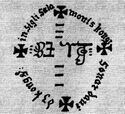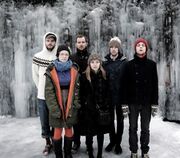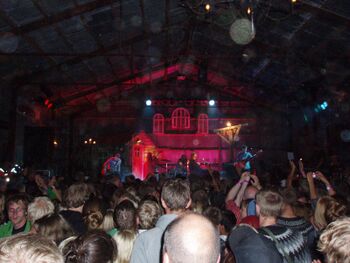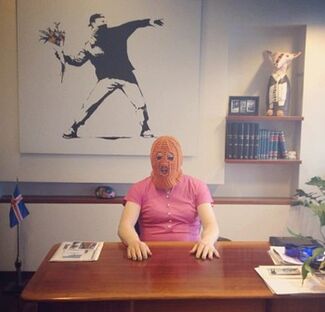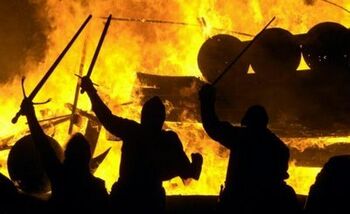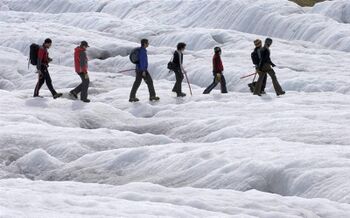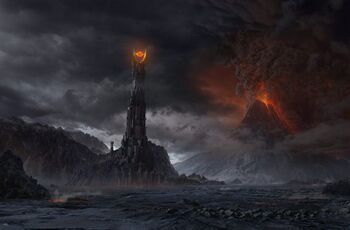Iceland
Iceland | |||||
|---|---|---|---|---|---|
| |||||
| Motto: '„Þetta Reddast“ (English:„Doesn't Our Water Taste Great?“(*)) | |||||
| Anthem: Við Höfum Líka Hljómsveitir Sem Eru Ekki Sigur Rós (*) | |||||
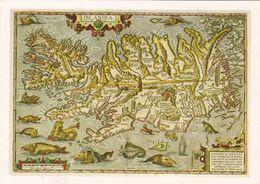 | |||||
| Capital | About $50. | ||||
| Largest city | Reykjavík | ||||
| Official language(s) | English (most residents also speak a little Icelandic) | ||||
| Government | Feminist Utopia | ||||
| National hero(es) | Anyone who people outside of Iceland have ever heard of. | ||||
| Declaration of Independence |
1944 (source: official), 2009 (source: liberal blogs)(*) | ||||
| Currency | Worthless coins with pictures of fish on them. Really. I mean, do we even need to make a joke here? | ||||
| Religion | What's that? | ||||
| Population | 6 | ||||
| Major exports | Fish, aluminum, $200 sweaters, bank IOUs, aloof facial expressions. | ||||
| National pastime | Sex(*) | ||||
| National sport(s) | Chess, Competitive Reading, Graffiti, Avoiding Eye Contact With Strangers(*) | ||||
| Drives on | Other cars | ||||
Iceland, not to be confused with Ireland, is a giant rock in the northern Atlantic ocean, inhabited by a large population of volcanoes and a small population of humans.
Culture
Clothing
While traditional Icelandic wear consists of things like „skautbúningur“, „hátíðarbúningur“, and „bjórblaut djammaföt“, today the „lopapeysa“ is widely seen as emblematic of Icelandic clothing. Made of a wool-fireant blend, they can be purchased today from tourist stores all along Laugavegur. A convenient way to purchase one is by signing over your home mortgage, which saves you the trouble of having to bring cash in a wheelbarrow.
Laugavegur is the main shopping street for fancy, expensive clothing in Reykjavík, as well as having many cafes, bars, clubs, and more stuffed puffins than there are real puffins in Iceland. Attentive visitors will catch on that in Icelandic, the word „vegur“ means „street“ while „laug(a)“ means „tourist“.(*)
Food
Iceland has a rich culinary tradition, which has in no way been influenced by the former NATO base at Keflavík. Traditional Icelandic foods include strange dishes like hamburgers (ground cow meat and condiments between two pieces of round bread) and pizza (a traditional dish made from „tomatoes“ atop a „crust“, with „cheese“ on top). Ice Cream, a traditional dessert, is so important that the country incorporated it into its name.(*)
The national drink of Iceland is coffee. The average Icelander consumes enough coffee in a week to drown a narwhal. As a side note, coffee-drowned narwhal is a delicacy in Iceland.
Language
The Icelandic language (norska) is an ancient and storied language. Classical Icelandic consists of tends of thousands of complex words and phrases. Modern colloquial Icelandic consists almost entirely of „Jú“, „Geðveikt“, „Snilld“, „Sko“ and „Er það ekki?“(*) The language is continuing to evolve - for example, the word "strax" ("immediately") is now a flexible concept[1]; "malta" is no longer the name of a country[2]; and "lofa" ("promise") no longer has any meaning[3].
As any book will tell you, the pronunciation in Icelandic is highly regular. For example, „l“ is pronounced like the English „l“. Except that the tongue is held flatter. Except when there's an „f“ before it, wherein it changes the „f“ to a „p“. Or when there's another „l“, wherein the two become a „tl“. Except on some words, wherein it becomes a „l“ again. Thankfully, since everyone learning Icelandic can intuit which words that happens with, you'll never hear an immigrant refer to „defective pants“ when buying jeans.(*)
Despite its incredible regularity in pronunciation, sometimes when speaking, words or phrases merge together and they get lost, a linguistic feature known as brotfall. Examples:
- Phrase: „I am reading.“ Spelling: „Ég er að lesa.“ Pronunciation: „Éralesa.“
- Phrase: „May I please have a beer?“ Spelling: „Má ég vinsamlegast fá bjór?“ Pronunciation: „Bjór.“
- Phrase: „I have deep personal emotions which I greatly want to discuss.“ Spelling: „Ég er með djúpar persónulegar tilfinningar sem mig langar rosalega til að ræða.“. Pronunciation: „...“ (Note: this rule only applies when the speaker is sober)
The number "1" has 24 different declension forms which must be used properly in sentences; "2", "3", and "4" each have 12 forms, while "5" and up have only a single declension form. Pro tip for identifying non-fluent Icelandic speakers in a shop: every item in their cart is in quantities of five or greater.
Icelandic is a very colorful language when it comes to the creation of words. Some examples include „skíthæll“ (shitheel) for beast, „smokkfiskur“ (condomfish) for squid, and „rúðupiss“ (window piss) for windshield wiper fluid, among countless other examples, and no, I'm not kidding.
Some common tips for learning Icelandic include:
- Maintain a blood alcohol content of at least 0.05.
- Make sure to keep sufficient marbles in your mouth when speaking.
- Memorize common greetings like „Talarðu ensku?“ and „Afsakið, ég er Bandaríkjamaður.“(*)
- Be born in Iceland.
Partying
Reykjavík has a world-famous late-night party scene, which is a nice way of saying that you can expect large crowds of drunks walking through the middle of town and peeing on the cabinet building between midnight and 6 AM on Friday and Saturday nights.(*)
Typical late-night Icelandic party games include „secret-confession relay“ and „beer-bottle shotput“.
Typical Icelandic party-wear around midnight includes stylish wool layers for men and skirts with black stockings and nice tops for women. Around 3 AM, the fashion standard is the same clothes but with beer spilled on them; and around 6 AM, the standard is no clothes.
With lax cultural attitudes about sexual activity, Iceland men have typically refined the pick-up to an artform, with such carefully crafted lines as, „Would you like to see my penis? It's really impressive.“(*) While men in most countries find their challenge to be getting a girl drunk enough that she'll lower her inhibitions and go home with him, in Iceland, the challenge is to prevent her from getting so drunk that she passes out or vomits all over him first. (Source: Quentin Tarantino.)
Music
Iceland has a surprisingly broad and diverse music scene. The average Icelander belongs to sixteen different bands, which are generally named after the singer, a close relative, a popular candy bar, or words pulled randomly from a hat. The combination of high production values/good talent and a low population density generally means that Icelandic music is the best music you will ever hear performed in a tiny community center or an abandoned fish factory.
To properly enjoy Icelandic music in a club or festival, arrive late, drink yourself blind-drunk, dance conservatively, sing along poorly, point out to tourists whenever a pre-recorded song was written by an Icelander, and do the Icelandic version of „Raise the Roof“ -- let your hand hang limp as you wave it around in the air out of time with the music, with an arbitrary number of fingers extended. A caution: If you and the crowd you are in are not yet blind-drunk, do not, and I repeat, *do not* sing, dance, raise your arms, or even move while the music is playing. Your social role is to sit quietly and emotionlessly, applaud for the regulation 8 seconds at the end of each song, and drink until you're having trouble remembering your name.
Beyond the concert scene, Iceland is also well known for its educational childrens' music. Okay, to be fair, the same applies to the concert scene.
Note To Tourists: Since Björk is the only Icelandic musician, like, ever, and since every Icelander totally loves her music because she's, like, from Iceland, be sure to tell every Icelander you meet how much you looooooove Björk. Be sure to really stress that „oar“ sound in the middle of her name. Talk about her all the time and try to get her address from everyone on the street. Because Björk totally wants you to visit her. Don't worry, you'll never come across as annoying, because, as we already mentioned, all Icelanders just totally love Björk, the country's only musician, like, evers.
In addition to popular music, like all nations, Iceland has a broad selection of traditional and patriotic music. Iceland's national anthem, for example, analogizes the country to a single little flower which prays to God, then dies with a quivering tear. For some inexplicable reason, it's not the most popular of Icelandic nationalistic songs.
Literature
Icelanders are proud of their long literary tradition, dating back to the first sagas written by the country's Viking settlers while the rest of Europe was too busy burning witches and pillorying scientists to care. Perhaps the most famous of these is Njáls' Saga, the story of a lawyer who ends up publicly burned to death, which is really just a great idea. Egil's Saga follows the life of a childhood axe-murderer who fights against King Eric Bloodaxe, and a bunch of other really metal stuff. Another famous saga, Laxdæla Saga focuses on a tragic love triangle; its slightly lower ratio of deaths per page make the earliest known piece of Icelandic „chick-lit“.
Icelanders have continued their literary tradition and currently boast the highest per-capita rate of book publication in the world. Sadly, the country's proud „axe murder“ tradition has largely died out. Most modern Icelandic literature is published in the form of „Facebook Posts“(*). Among the youth, Facebook friends of the opposite gender are typically accumulated through a time-honoured tradition which is known as „sleeping with them“.(*)
Comedy
Iceland has a rich comedic tradition which carries through to the modern day. Some sample Icelandic jokes:
- „A standup comedian walks into a polling place. He gets elected mayor of Reykjavík.“
- „What is the typical Icelandic reaction to meeting someone famous on the street? Going up to him and asking him if he wants your autograph.“
- „How do you get rid of the stockbroker at your front door? Pay him for the pizza.“
- „Why were the gables staring at the sky all night? Because the weather forecast called for flying ice.“ (this one loses a little something in the translation...)
- „How do you find your way out of an Icelandic forest? Stand up.“
This latter joke is taught to every Icelander at age three in íslenskaskógabrandaraskóli(*), where students are taught how to pronounce the words in English and how to feel comfortable telling it to foreign tourists. This leads to the lesser-known meta-joke, „How can you tell if someone is or has ever met an Icelander? Ask them if they know how to find their way out of an Icelandic forest.“
Holidays and Festivals
- Páska (Easter): Celebrated by buying one's children a gigantic, hollow, candy-filled chocolate egg (páskaegg), large enough for them to hide inside. This holiday has been endorsed by the insulin-syringe manufacturing industry.
- 1 maí (International World Workers Day): Celebrated by parades, public speeches praising socialism and the struggles of the workers, and singing of songs like „The International Song of the Proletariat“ (Alþjóðasöngur Verkalýðsins) in political rallies with the prime minister or opposition parties. Seriously.
- 17 júní (Independence Day): Celebrated by parades, flags, and hooking your children up to an IV drip of sugar. Also endorsed by the insulin-syringe manufacturing industry.
- Verslunarmannahelgi (Businessmen's Weekend): A long weekend in which Icelanders break from the monotony of everyday life and travel to Vestmannaeyjar to get drunk instead of doing so in Reykjavík. Also known as Samþykki-Er-Aukalegt Helgi.(*)
- Hinsegin Dagar (Queer Days, aka Reykjavík Gay Pride): Possibly the largest annual family festival in Iceland, attended by over 100,000 people, 1/3rd of the country's population, including major politicians dressed in drag. Seriously.
- Menningarnott (Culture Night): Like Hinsegin Dagar, but with more fireworks and fewer rainbows.
- Jól (Christmas): The time of year when children prepare to be visited by 13 quasi-evil santas who do things like steal from them and lick their spoons, a giant cat who will eat them if they don't get new clothes for Christmas, and their mother, who kidnaps naughty children in a sack to make into soup. Seriously.
- Björgólfur-Þór-Verður-Handtekinn Dagur: Djók.
Sports
While the official national support is Glíma, a traditional form of wrestling, the two most common sports in Iceland today are football and handball. In 2008 Iceland became the world's smallest nation to take an Olympic medal in a team sport when its handball team medaled in the Beijing Olympics.
Clarification for Americans: „Football“ is a game which the rest of the world plays, which involves kicking around a ball with your feet. It does not involve running around with an egg-shaped object held in your hands. You are playing handegg. Deal with it.
Clarification for Americans: „Handball“ is not a sport that you've vaguely heard of involving hitting a ball against a wall. It's one of the most popular sports in the rest of the world, sort of a cross between basketball and football (note: not handegg). It's what you may call „olympic handball“ or „team handball“ or... oh, who are we kidding, you don't call it anything because you've never heard of it.
Clarification for Americans: The „rest of the world“ means „people who don't live in America.“ There are actually quite a few of them.
Relationships
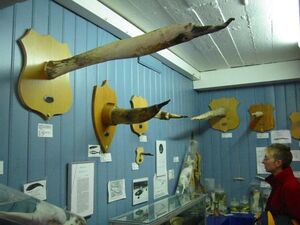
Iceland competes with Ireland for the honor of „highest birth rate in Europe“, albeit with a different approach. While Ireland's approach is generally „get married and don't use birth control“, Iceland's approach is typically the less-specific „have lots of sex without protection“ method - an approach which lacks the approval of the Catholic Church but gains the endorsement of the Chlamydia Promotion Council.
In most western nations, the general approach to dating proceeds as follows:
- Meet -> Get to know each other -> Start dating -> Get married / start having sex (order of these two depends on the individuals) -> Optionally have kids.
In Iceland, the general approach to dating proceeds is as follows:
- Get at least a bit tipsy -> Meet -> Have sex -> Get to know each other while having more sex -> Start dating -> Have kids -> Optionally get married.(*)
Iceland is the first nation in the world to have a LGBT head of state (Jóhanna Sigurðardóttir). Her sexuality was a topic of such relevance in the campaign that when a request went out for rats asses, nobody gave one. Iceland also passed a same-sex marriage bill in the Alþing with a vote of 59-0. As a result of these cultural attitudes, LGBT travel to Iceland is promoted by the Iceland Tourism Council under the slogan „Pink Iceland“ and by the American Christian Coalition under the slogan „Free One-Way Tickets For Sodomites“
Despite the country's openness toward sex and sexuality, there is a strong feminism movement which advocates policies to try to prevent trafficking and exploitation of womens' bodies. Surrogacy is illegal, as are ads depicting sexuality, and even strip clubs are banned. This may come as a surprise to people who come to Iceland and visit Goldfinger or Strawberries, which may at first *appear* to be strip clubs; however, the women are now "volunteers" at "champaigne clubs". Naturally, when a reporter reported on this sneaking around of the law, the Supreme court ruled harshly against the reporter, citing a violation of the club owners' inherent Icelandic right to try to circumvent legislation they don't like.
Economy
Tourism
Iceland is famous for being a tourist destination, and perhaps no place in Iceland is better known than the blue lagoon spa Bláa Lónið -- Icelandic for „Most Profitable Power Plant Waste Ever“. Famed for its warm, gamete-laden waters(*), it is a place where one can experience the feel of mud facial, the warmth of a steam room, and the soothing lull of squabbling British tourists.
Iceland is blessed with many large waterfalls. Due to its large size and convenient location, the most popular of these is Útsýnispallur Falls. This is usually viewed on a one-day loop tour along with Hætta Geysir and Varúð Hot Springs.(*)
The largest church in Iceland, the Hallgrímskirkja, stands in downtown Reykjavík. Its most innovative design feature is the Camera Magnet in the viewing platform, which was installed to ensure that nearly every photograph in the city is either taken from or of this location.
Banking
Iceland's economy has long been driven by a "creative culture" which allowed people to stay alive against adversity in a harsh land. This same creativity extended to the banking sector, leading to a variety of creative financial products, creative debt concealment, and creative ways to make the graph of a country's GDP look like a double-diamond ski-slope.
Iceland's banks were not just big in local terms, but even in global terms. Many Americans think of Lehman Brothers as a catastrophically large financial collapse, half a dozen times larger than the famous Enron failure. While Iceland has only 1/1000th the population of the United States, the combined size of the bankruptcies of its three largest banks were half the value of the Lehman Brothers bankruptcy. Per-capita, it's like 500 Lehman Brothers all collapsed at once.
Actually, there's no joke here. I mean, just, whoa. Dude.
Fishing
Iceland is fortunate to live in one of the world's richest fisheries and unfortunate enough to live close to the UK, who at regular intervals seems to have difficulty grasping that it is not their fishery.
The importance of fishing to the nation can be seen in common fishing-related phrases such as "life is a saltfish", "it's not worth a lot of fish", and "if you don't stop trawling our waters we're going to cut your nets you limey bastards".
Aluminum
Electricity in Iceland is cheap and relatively clean, with well over 99% of power coming from geothermal and hydroelectricity. The power must be used locally because neither Byko nor Húsasmiðjan, nor even Bauhaus sell 1000-kilometer extension cords to connect the island to the UK. IKEA sells one but it comes in hundreds of pieces and Orkuveita can't figure out how to assemble it.
Traditionally, the use of these power resources is done through importing aluminum ore, refining it, and selling the aluminum. Even the smallest of Iceland's three smelters uses more power than all the homes and businesses in the country combined.(*) Many Icelanders depend on the smelters for their jobs, to make it through the winter and feed their families, so remember, kids - every time you recycle a can, an Icelandic baby goes without a meal.
(This message has been brought to you by your friends at Alcoa. "Alcoa: We Pillage The Earth So You Don't Have To!")'
Climate
Iceland has a storm-prone subarctic maritime climate, which is a fancy way of explaining to tourists why they suddenly went from „enjoying a nice sunny day“ to „huddling for warmth in the bottom of a crevasse and praying for death“. Average January temperatures in Reykjavík are -0.8C and average July temperatures are 12C, with a standard deviation of +-40C.
Winds in Iceland can be intense, and seem to have been the inspiration for two popular sports among tourists, „Unanticipated Parasailing“ and „Vehicular Cliff-Diving“.
The unpredictable nature of the Icelandic climate has led to adaptations among the domestic livestock, including a breed of „leader sheep“. These are sheep bred not for meat, wool, or milk, but intelligence, who can recognize danger and help guide the flock home in times of threat. Leader sheep currently make up approximately 40% of the membership of the Icelandic parliament. The weather has also encouraged the development of the Icelandic horse's long hair for insulation and the Icelandic sheepdog's incessant barking to scare away Þór, Son of Óðinn and Bringer of Storms.
Geography
Iceland is traditionally divided into eight regions:
- Höfuðborgarsvæði, the Capital Region: Two thirds of Iceland's population lives here. House prices range from $250,000 USD to the GDP of Haiti.
- Suðurnes, the Southern Peninsula: Also known as Flugvallarnes, this area contains Iceland's highest concentration of tourists submerged in blue water.(*)
- Vesturland and Vestfirðir: Iceland's geographically oldest provinces, some of the rocks here are over 300 years old and no longer hot to the touch.
- Norðurland vestra, the Northwest: There's probably something worth writing about for this region.
- Norðurland eystra, the Northeast: Contains Akureyri, Iceland's largest city outside the capitol region. This burgeoning metropolis, with a population nearly that of Harker Heights, Texas, proudly boasts the motto, „We don't all fit into a phone booth anymore.“(*)
- Austurland, the East, and Suðurland, the South: Contains most of Iceland's strategic Surface-To-Air Volcano batteries.
Volcanism
Being a tectonically active nation, regions in Iceland are demarcated by their VSM rating („Volcanoes per Square Meter“), ranging from a low of 0.06 in Vestfirðir to 0.8 in Suðurland. Due to this high volcanic activity, Iceland is constantly having new material added to it, a mixture of cooled lava, deposited tephra, and debris from downed commercial aircraft.
Many of Iceland's volcanoes are capped by glaciers. These can lead to catastrophic jökulhlaup floods during eruptions which can take out bridges. The average highway bridge in Iceland is rebuilt in a matter of days, leaving the old bridge's debris as new playground equipment for children. No, really. As a side note, tetanus and missing limbs are common fashion statements among Icelandic children.
Perhaps the most famous of Iceland's volcanoes in modern times is Eyjafjallajökull, which loosely translates as, „Revenge For Classifying Iceland As A Terrorist Organization“. Its eruption in 2010 took out travel throughout much of Europe, and more importantly, gave Icelanders sufficient opportunity to use as a backdrop for pictures to make themselves look töff.(*)
The most devastating eruption Iceland's history was the 1783 eruption of Laki, which killed six million people and 80% of Iceland's sheep, the latter of which bothered Icelanders a great deal more due a spike in the price of lamb.(*)
Some people in Iceland blame the country's natural disasters on the huldufólk -- little people who skulk about the wilderness. While it can be easy to dismiss this as quaint folk beliefs, tourists are advised to carefully guard their precious.
History
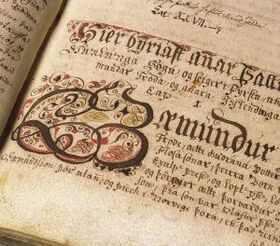
While there is some evidence of earlier settlement activities, the Icelandic sagas describe the primary settlement of Iceland in the 10th century AD as being primarily due to Norse aristocrats, fleeing King Harald Fairhair of Norway's taxes on the kingdom's „1%-ers“ to fund a range of social programs (bailouts of the longship industry, healthcare for thralls, etc). The settlers first travelled to Ireland and Scotland, where they stocked up on provisions (sheep, barley, gaelic mitochondrial DNA reservoirs) before travelling to Iceland and founding the first settlements.
Within six decades, the whole of Iceland was settled, and to prevent strife, they founded the world's oldest parliament (the Alþing), which is sort of like setting up a Grateful Dead concert to benefit the War on Drugs.
After extensive proselytizing from Norway, a conflict between Christians and Pagans erupted in Iceland, which was sent to the Alþing for a settlement (that being the „Iceland Becomes Christian; Pagans, You Can Suck It“ compromise). A new era of peace and prosperity involving violent and brutal warfare reigned until Icelandic chieftains reached a new settlement (the „Give The Country To Norway So They Can Stop Us From Killing Each Other“ accord).
When power in Norway was ceded to Denmark, Iceland became a Danish commonwealth state, which asserted increasing control and ultimately banned the Alþing (the 1800 „Suck It, Iceland“ decree). Iceland retaliated in 1944 with its „Since You're So Busy Being Occupied By The Nazis...“ resolution declaring the nation's independence.
In 1940, the British introduced themselves to Iceland by occupying it, in order to prevent a non-existent Nazi plan. Codenamed „Operation Bungling Baffoon“, it involved sending a fleet of sailors who had never been on a ship before and nobody who spoke Icelandic to the country, making sure that Iceland and its German embassy knew about the invasion well in advance by buzzing the harbor with an airplane, and being so slow to disembark that the curious Icelanders had to be asked to step aside to allow their new sovereigns enough room to walk ashore. Seriously.
After the war, a message („FYI, Iceland Isn't Part Of The UK. -- Bestu kveðjur, Iceland“) was inadvertently lost after the postman consumed too many shots of brennivín, and the British embarked on a policy of fishing up all of the „clearly British cod that just happen to live in Icelandic waters“. Iceland forced them out over a series of „Cod Wars“ during the next several decades, keeping a bill on the value of the captured cod. This bill was collected in 2008 during „Operation Icesave“.(*)
See Also
| Featured version: 4 December 2011 | |
| This article has been featured on the main page. — You can vote for or nominate your favourite articles at Uncyclopedia:VFH. | |

